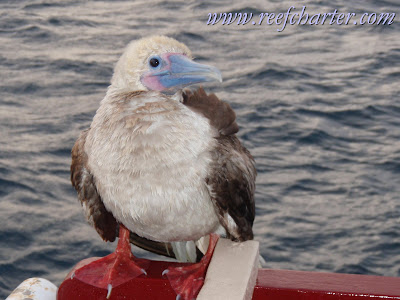A common sight on the reef are the Booby Birds scanning the oceans in search of food. The Booby, a type of seabird, is part of the family Sulidae and the genus Sula. It is closely related to the gannets (Morus), which were often included in Sula in former times.
Boobies are large birds, with long pointed wings and long bills. They hunt fish, by diving from a height into the sea and pursuing their prey underwater. Facial air sacs, under their skin, cushion the impact with the water. Boobies are colonial breeders on islands and coasts. They normally lay one or more chalky-blue eggs, on the ground or sometimes in a tree nest.
Their name is possibly based on the Spanish slang term bobo, meaning “dunce”, as these tame birds had a habit of landing on-board sailing ships, where they were easily captured and eaten. Owing to this, Boobies are often mentioned as having been caught and eaten by shipwrecked sailors, notably Captain Bligh of the Bounty and his loyalists, during their famous voyage after being set adrift by Fletcher Christian and his mutineers.
Birds of the Great Barrier Reef – The Nightjar
Not only do you get to see some great reefs, dolphins, and fish on our trips you also get to experience the birds that inhabit the Great Barrier Reef. One of these seen in the reef is the Night Jar.
Nightjars are medium-sized nocturnal or crepuscular birds with long wings, short legs and very short bills. They are sometimes referred to as goatsuckers from the mistaken belief that they suck milk from goats (the Latin for goatsucker is Caprimulgus). Some North American species are named as nighthawks. Nightjars usually nest on the ground.
Nightjars are found around the world. They are mostly active in the late evening and early morning or at night, and feed predominantly on moths and other large flying insects.
Most have small feet, of little use for walking, and long pointed wings. Their soft plumage is cryptically coloured to resemble bark or leaves. Some species, unusual for birds, perch along a branch, rather than across it. This helps to conceal them during the day. Bracken is their preferred habitat.
Nightjars lay one or two patterned eggs directly onto bare ground. It has been suggested that nightjars will move their eggs and chicks from the nesting site in the event of danger by carrying them in their mouths. This suggestion has been repeated many times in ornithology books, but while this may accidentally happen, surveys of nightjar research have found very little evidence to support this idea.
Customer Satisfaction Surveys for March 2009
The latest customer satisfaction scores have come back from JCU. Again another great performance from our crew and the local reef and wildlife, showing guests the best parts of the Barrier Reef and providing unforgetable experiences enjoyed by all.
Satisfaction:
Trip Met Expectations: 91% said very much
Received Value for Money: 100% said yes
Would Recommend the Trip: 96% said yes
Average Satisfaction Score: 8.84 /10
Qantas Airfare Specials from Frankfurt, Germany to Cairns
Qantas have released another round of airfare specials to Cairns this time from Frankfurt, Germany.
Some great deals on offer in Economy Class for travel from 14 April until 23 June 2009.
Hurry, offer ends 30 April 2009!
Frankfurt to Cairns return from EUR914
Full Details can be found at the airline website.
Don’t forget to book your Australian Great Barrier Reef Dive & Snorkel Trip before you leave.





